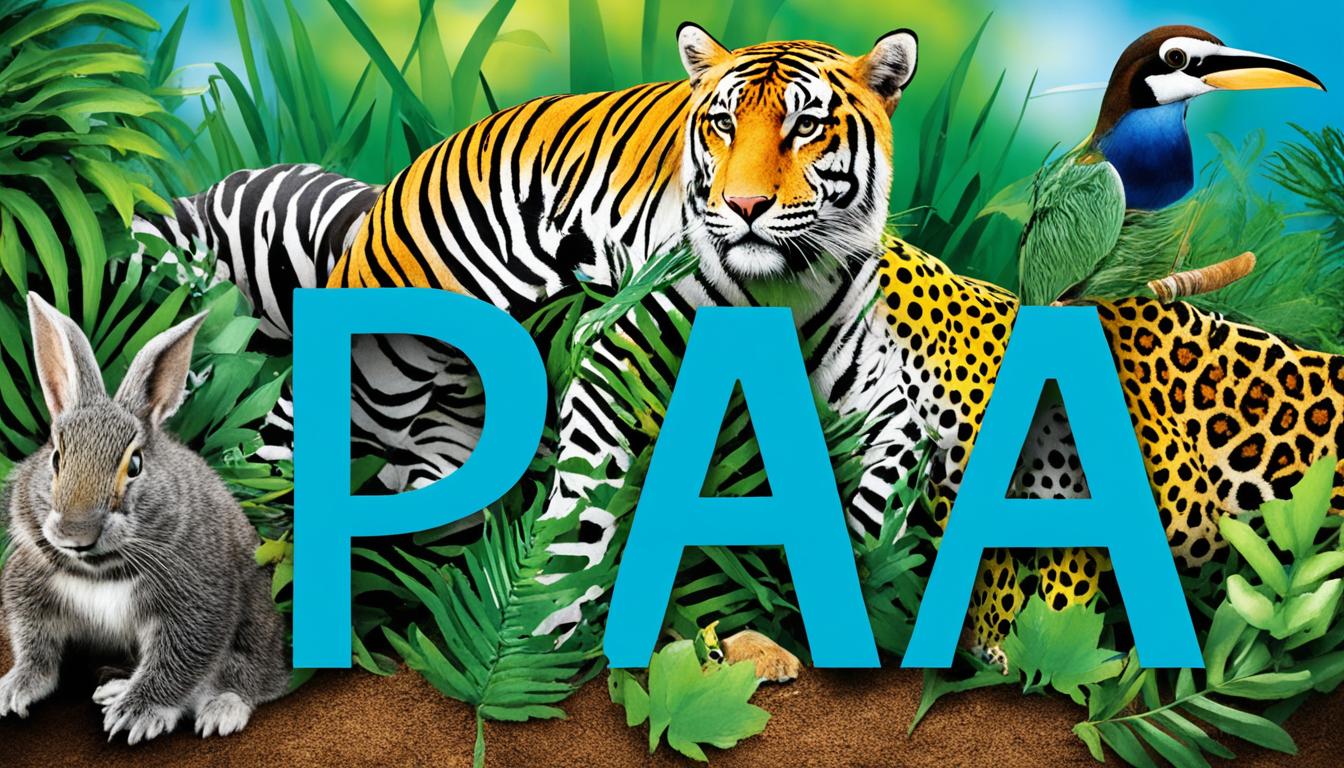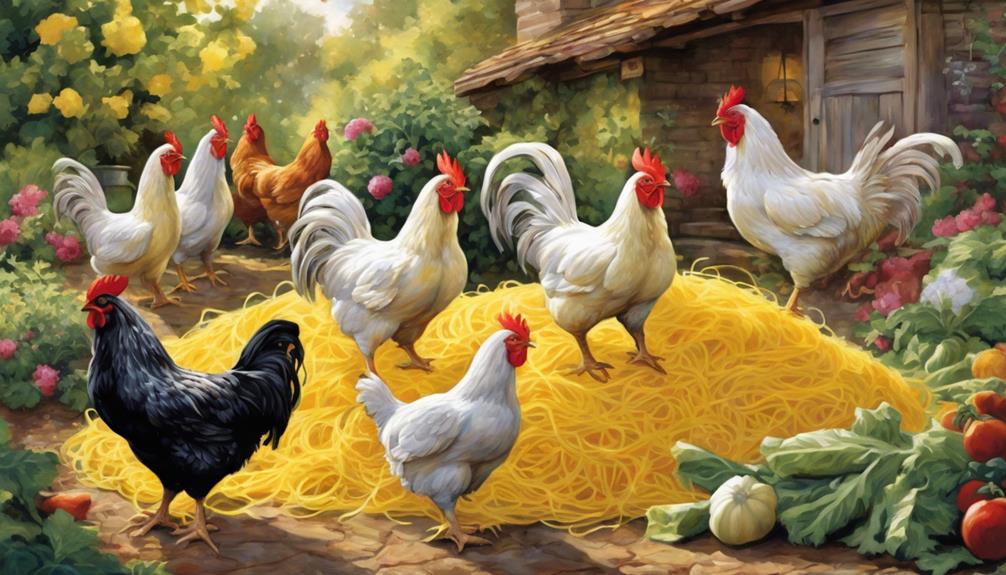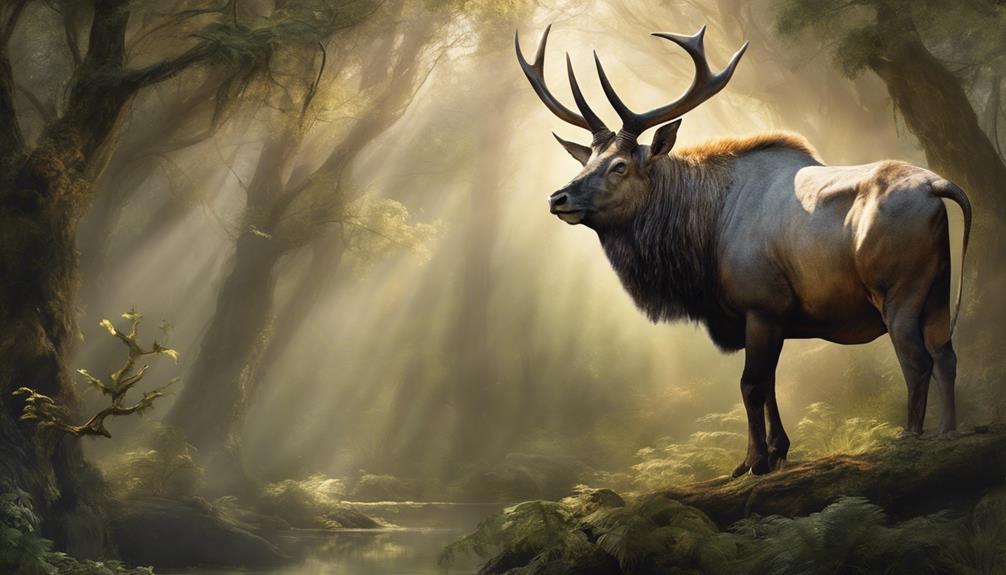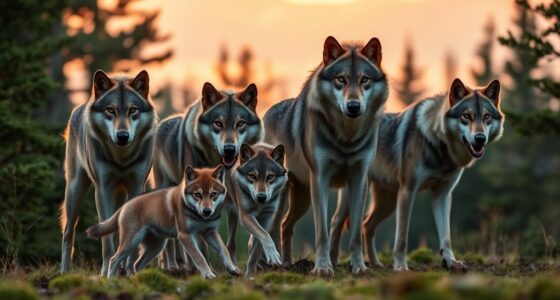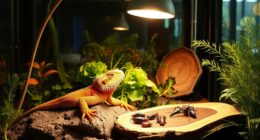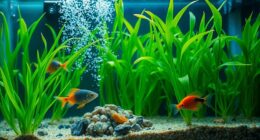Did you realize that the animal kingdom is teeming with a vast array of fascinating creatures, including numerous animals that begin with the letter I? From mammals to birds, reptiles to invertebrates, these creatures exhibit distinct characteristics that showcase the extraordinary diversity of life on our planet.
In this article, we will take a closer look at some of these fascinating animals from the animal kingdom. Prepare to be amazed by the incredible adaptations, behaviors, and habitats of animals such as the indri, impala, Indian elephant, ibis, Iceland gull, icterine warbler, iguana, immortal jellyfish, and many more.
Join us on this journey of discovery as we delve into the captivating world of animals that start with I. Let’s explore the intricacies of their lives and gain a deeper appreciation for the wonders of the natural world.
Key Takeaways:
- Animals that start with I showcase the remarkable diversity of the animal kingdom.
- These creatures range from mammals and birds to reptiles and invertebrates.
- Each animal has unique characteristics and adaptations that contribute to their survival.
- Understanding and appreciating these animals can help support conservation efforts.
- Exploring the animal kingdom introduces us to the wonders of our natural world and fosters a greater sense of awe and reverence for all living creatures.
Ibex
The ibex is a fascinating wild goat that thrives in the mountainous regions of Europe, Asia, and Africa. Renowned for its exceptional climbing abilities, the ibex can be found navigating the treacherous terrains of rocky landscapes with ease. Both males and females of this species possess curved, ridged horns, making them a distinctive presence in their natural habitats.
The ibex belongs to the Capra genus, which includes other species of goats. These majestic animals play a vital role in their ecosystems, contributing to the delicate balance of mountainous regions. Their adaptability to rugged environments showcases their remarkable resilience and survival skills.
Through their agile climbing abilities and unique physical features, ibexes have successfully thrived in their challenging habitats for centuries. By exploring the ibex and its role within the Capra genus, we gain a deeper appreciation for the diversity and remarkable adaptations found in the animal kingdom.
Ibis
The ibis is a fascinating wading bird that can be found on all continents except Antarctica. With its long, thin legs and distinctive curved bill, the ibis belongs to the Threskiornithidae family, which includes various species of ibis.
One of the most widely distributed species of ibis is the glossy ibis, known for its shiny plumage. These beautiful birds play a crucial role in maintaining the balance of wetland ecosystems. They are known for their ability to wade in shallow waters in search of food, using their specialized bill to probe and capture prey.
The ibis’s unique appearance and behaviors make it a popular subject of study and admiration among bird enthusiasts and researchers. Their graceful movements and striking features make them a joy to observe in their natural habitats.
Here is an attractive visual representation of a glossy ibis in all its glory:
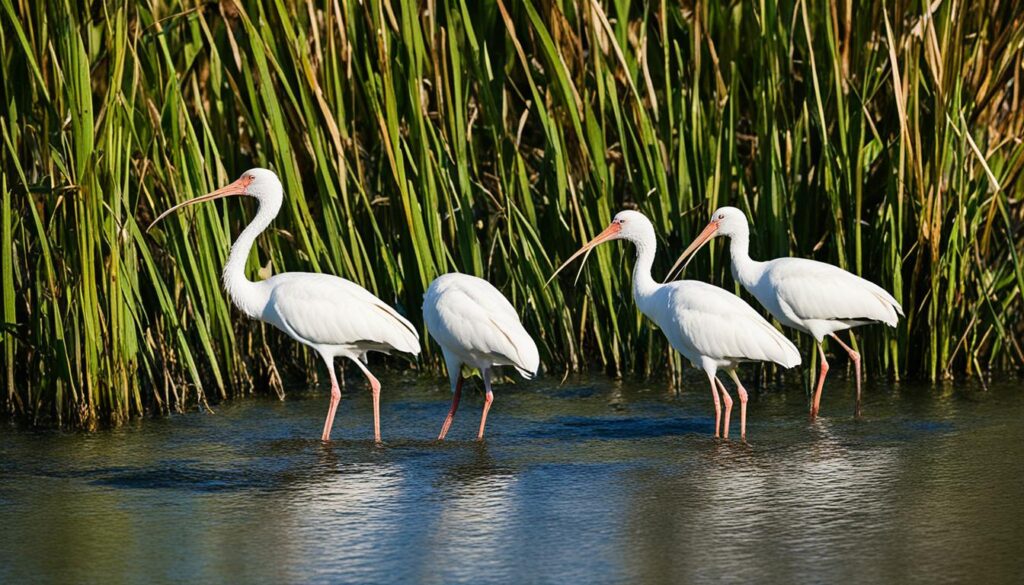
Iceland Gull
The Iceland gull, scientifically known as Larus glaucoides, is a mid-sized gull that breeds in the Arctic regions of Greenland and north Canada. Despite its name, it does not breed in Iceland. During the winter months, the Iceland gull migrates south and can be spotted in the northern states of the contiguous United States and the UK.
This fascinating bird belongs to the Laridae family and is characterized by its stunning white plumage. With its graceful flight and striking appearance, the Iceland gull is a captivating sight for birdwatchers and nature enthusiasts.
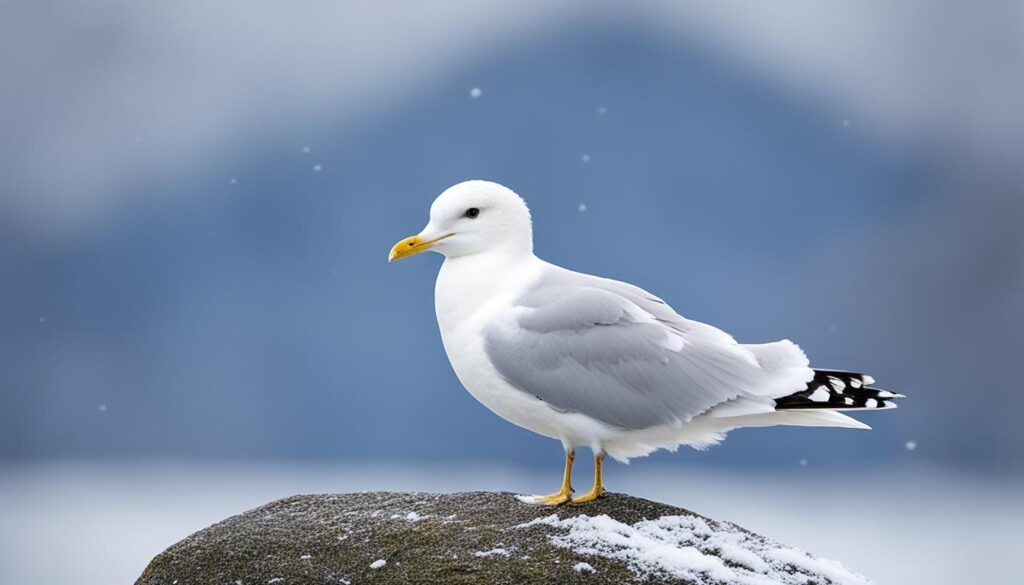
Key Characteristics of the Iceland Gull
- Size: Mid-sized gull
- Color: White plumage
- Breeding Location: Arctic regions of Greenland and north Canada
- Migration: Winter migration to the northern states of the contiguous United States and the UK
- Fascinating Fact: Although not a breeding ground, Iceland gulls can be seen in Iceland during migration.
The presence of the Iceland gull in the Arctic and its ability to thrive in such extreme conditions highlight its remarkable adaptations and resilience. As a species that frequents the Arctic region, the Iceland gull serves as an indicator of the health and balance of this unique ecosystem.
“The Iceland gull’s distinctive plumage and its presence in Arctic regions make it a captivating bird for nature enthusiasts.”
— [Your Name]
Conservation Status of the Iceland Gull
The Iceland gull is not currently listed as an endangered species. However, the protection of its breeding grounds and the preservation of its Arctic habitat are crucial for the long-term survival of this species. Climate change and habitat degradation pose significant threats to the Arctic ecosystem, making conservation efforts more important than ever.
| Scientific Name | Common Name | Conservation Status |
|---|---|---|
| Larus glaucoides | Iceland Gull | Not Endangered |
Icterine Warbler
The icterine warbler (Hippolais icterina) is a small migratory bird that breeds in Europe during the summer and spends the winter in tropical Africa. It is named for its yellowish color and belongs to the Acrocephalidae family.
Icterine warblers are typically found in forests and woodlands, where they build their nests in tree branches. These warblers have an interesting diet, which includes insects and ripe fruits.
Characteristics of the Icterine Warbler
- Size: Approximately 12-13 centimeters in length
- Color: Yellowish plumage with a pale belly
- Vocalization: Melodic and flute-like song
- Migratory Pattern: Breeds in Europe and migrates to tropical Africa for the winter
The icterine warbler is a visually striking bird with its vibrant yellow feathers, making it a delight to observe in its natural habitat. Its beautiful song adds to the enchantment of encountering this bird while exploring the European and African woodlands.
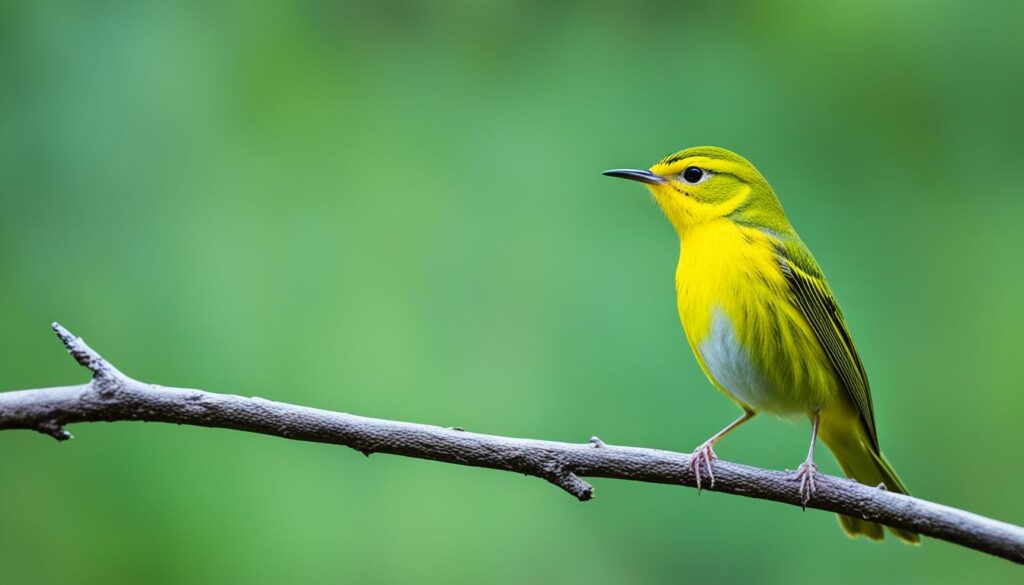
The Importance of the Icterine Warbler
The presence of icterine warblers in both Europe and Africa highlights their significance in maintaining the ecological balance of these regions. By feeding on insects, they help control populations that may otherwise become pests. Additionally, their preference for ripe fruits contributes to the dispersal of seeds, supporting forest regeneration.
In the words of John Muir, “When we try to pick out anything by itself, we find it hitched to everything else in the universe.”
Conservation Status and Threats
The icterine warbler is currently listed as a species of “Least Concern” by the International Union for Conservation of Nature (IUCN). However, habitat loss and degradation pose significant threats to its long-term survival. Sustaining the health and diversity of forests and woodlands, along with maintaining connectivity among suitable habitats, are crucial for the conservation of this species.
Iguana (Green)
The green iguana, scientifically known as Iguana iguana, is a striking lizard that resides in the lush forests of Central and South America. This magnificent creature belongs to the Iguanidae family, which comprises various species of iguanas.
Renowned for its impressive size, the green iguana showcases an intimidating appearance with its long tail, sharp claws, and robust body. The males, known as bulls, can reach lengths of up to six feet, making them one of the largest species of lizards in the world.
While the green iguana’s name reflects its distinctive coloration, it is important to note that they also come in shades of brown and gray. This remarkable reptile has adapted to its environment by blending into the dense foliage with its remarkable camouflage.
As primarily herbivorous creatures, green iguanas feast on a diet consisting mainly of leaves, fruits, and flowers. Remarkably, they have a unique symbiotic relationship with birds called green iguana finch. These birds act as cleaners, removing parasites from the iguana’s skin.
With their excellent climbing and swimming abilities, green iguanas are true masters of their domain. They effortlessly maneuver through the treetops, bask in the sun, and even dive into rivers and streams to escape predators or regulate body temperature.
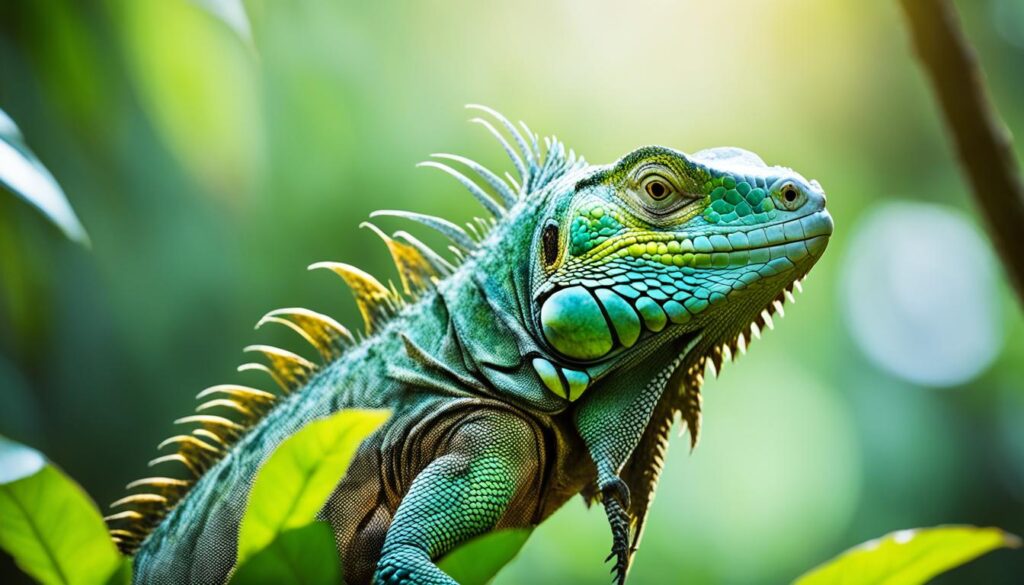
“The green iguana is a fascinating reptile that thrives in the rich biodiversity of Central and South American forests. Its size and impressive adaptations make it a truly remarkable creature.”
Immortal Jellyfish
The immortal jellyfish, scientifically known as Turritopsis dohrnii, is an extraordinary hydrozoan with unique abilities. Found in temperate to tropical saltwater environments worldwide, this small creature showcases remarkable regenerative powers that have earned it the nickname “immortal jellyfish”.
The immortal jellyfish possesses the extraordinary ability to revert back to its polyp state and start its life cycle anew. This process, known as transdifferentiation, allows the jellyfish to renew its cells and essentially cheat death. By transforming its cells, the immortal jellyfish can regenerate its entire body, giving it the potential for immortality.
Predators of the immortal jellyfish include sea turtles and various fish species, although their ability to revert back to their polyp state aids in their survival. This incredible adaptation has made the immortal jellyfish a subject of fascination among scientists and researchers.
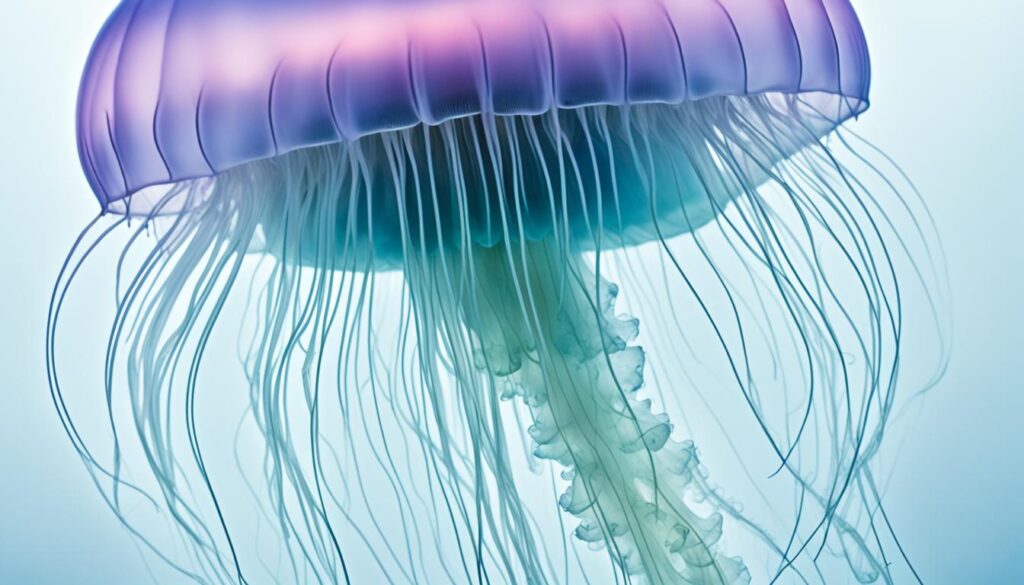
| Scientific Name | Common Name | Habitat |
|---|---|---|
| Turritopsis dohrnii | Immortal Jellyfish | Temperate to tropical saltwater environments worldwide |
The immortal jellyfish possess an omnivorous diet, consuming a variety of small marine organisms to sustain themselves. Their ability to survive and thrive in different oceanic conditions contributes to their wide distribution.
While the immortal jellyfish may be biologically immortal, it still faces challenges in the ever-changing marine ecosystem. Pollution, habitat loss, and climate change threaten their survival, underscoring the importance of conservation efforts to protect these remarkable creatures and the fragile marine environments they inhabit.
Quote: “The immortal jellyfish showcases nature’s ability to adapt and rejuvenate, reminding us of the immense diversity and resilience of marine life.” – Marine biologist, Dr. Jane Thompson
The Immortal Jellyfish’s Key Characteristics:
- Biologically immortal due to its ability to revert to the polyp state
- Transdifferentiation allows for complete regeneration of the jellyfish’s body
- Omnivorous diet to sustain itself
- Found in temperate to tropical saltwater environments worldwide
- Predators include sea turtles and various fish species
Impala
The impala, scientifically known as Aepyceros melampus, is a mid-sized antelope native to the savannas of East and southern Africa. With its striking reddish-brown coat and graceful appearance, the impala is a well-known and iconic African species. Both males and females possess elegant, lyre-shaped horns that can reach impressive lengths.
Renowned for its agility, the impala is a master of leaping, capable of clearing heights of up to 10 feet and distances of up to 30 feet. This incredible leaping ability allows impalas to swiftly evade predators such as lions, cheetahs, and wild dogs that inhabit their natural habitat.
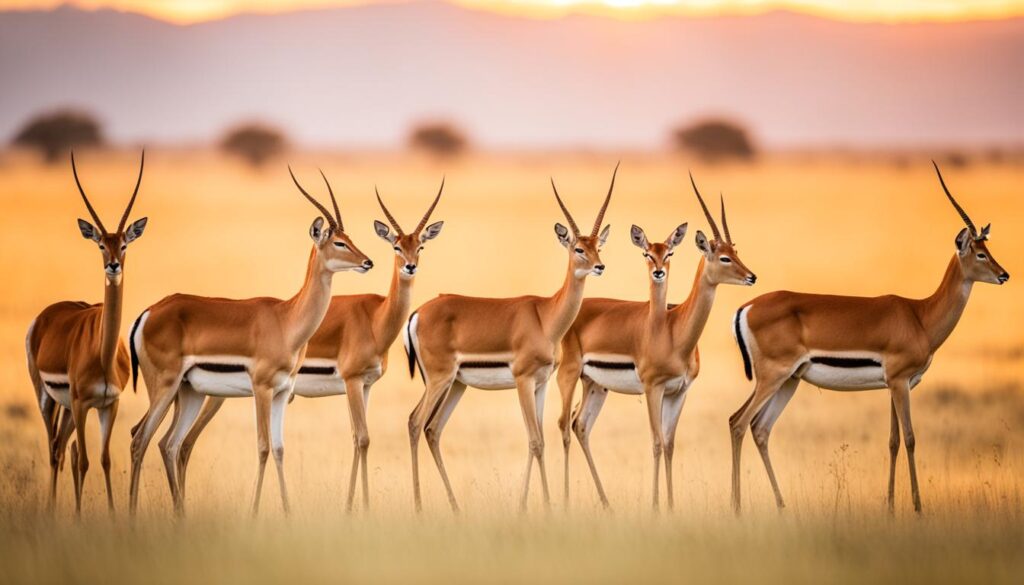
Impalas are highly social animals that live in herds ranging from small groups to larger aggregations of over 100 individuals. They form complex social structures and exhibit fascinating behaviors, such as synchronized breeding and “pronking,” a unique form of jumping that signifies excitement or warning among group members.
As a vital prey species, impalas play a crucial role in the savanna ecosystem. Their abundance and ability to adapt to various habitats make them a reliable food source for predators, ensuring the balance of the intricate web of life in African savannas.
Key Features of the Impala:
- Mid-sized antelope with a reddish-brown coat
- Both males and females possess lyre-shaped horns
- Remarkable leaping ability to evade predators
- Highly social animals that live in herds
- Plays a vital role as a prey species in the savanna ecosystem
| Scientific Name | Common Name | Habitat | Conservation Status |
|---|---|---|---|
| Aepyceros melampus | Impala | Savannas of East and southern Africa | Least Concern |
Indian Bullfrog
The Indian bullfrog, scientifically known as Hoplobatrachus tigerinus, is the largest frog species found in South Asia. With a weight of up to 771 grams and a length of 16.8 cm, this impressive amphibian showcases the incredible biodiversity of the region.
Indian bullfrogs are voracious predators, preying on a wide range of animals like insects, small fish, and even snakes. They have a robust build and powerful hind legs, allowing them to swiftly capture their prey.
These remarkable frogs can be found in diverse habitats including freshwater wetlands, forests, and coastal areas. With their adaptable nature, they have successfully adapted to live in various environments throughout South Asia.

The Indian bullfrog faces several challenges, however, including habitat loss and water pollution. As human activities continue to encroach upon their natural habitats, their populations are declining. Conservation efforts are crucial in protecting the Indian bullfrog and ensuring the preservation of its unique ecological role.
| Common Name | Scientific Name | Weight | Length | Preferred Habitat |
|---|---|---|---|---|
| Indian Bullfrog | Hoplobatrachus tigerinus | Up to 771 grams | 16.8 cm | Freshwater wetlands, forests, coastal areas |
The Indian bullfrog (Hoplobatrachus tigerinus) is not only the largest frog found in South Asia but also a fascinating species that highlights the incredible diversity of the region. With its impressive size, voracious appetite, and adaptability, the Indian bullfrog plays a vital role in its ecosystem.
Indian Crested Porcupine
The Indian crested porcupine (Hystrix indica) is a large rodent native to Asia. It belongs to the Hystricidae family and is known for its distinctive spines, or quills, that cover its back. These quills serve as a defense mechanism, deterring potential predators.
This fascinating rodent is primarily herbivorous, with a diet that includes leaves, bark, and fruits. It inhabits various habitats across Asia, including forests and grasslands. The Indian crested porcupine is a solitary animal, typically active at night, and has a strong sense of smell to help it navigate its surroundings.
Despite its sharp quills and robust appearance, the Indian crested porcupine is a non-aggressive animal, preferring to avoid confrontations. It is generally docile and only resorts to using its quills as a last line of defense.
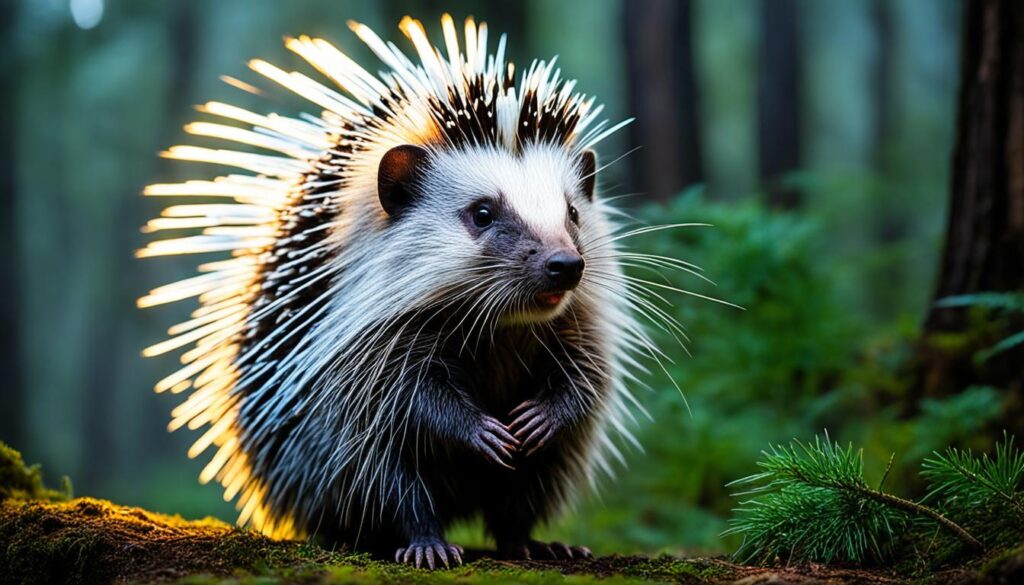
The conservation status of the Indian crested porcupine is currently listed as least concern, indicating that its population is relatively stable. However, habitat loss and fragmentation pose threats to its long-term survival. Efforts to protect its natural habitat and raise awareness about its ecological importance are crucial for ensuring the continued existence of this remarkable rodent species.
Indian Elephant
The Indian elephant, scientifically known as Elephas maximus indicus, is a magnificent creature native to the Indian subcontinent. As the largest land animal in Asia, it holds a vital role in maintaining the delicate balance of the ecosystem it inhabits.
Indian elephants are herbivorous, relying on a diet of grass, leaves, bark, and fruits to sustain their substantial size. These gentle giants possess remarkable intelligence and exhibit a close-knit social structure within their herds.
Despite their significance in the natural world, Indian elephants face numerous challenges. Habitat loss due to human activities, including deforestation and urbanization, poses a threat to their survival. Additionally, conflicts between humans and elephants often arise, leading to detrimental outcomes for both species.
Efforts are being made to support the conservation of Indian elephants and protect their habitats. These initiatives involve employing sustainable practices, promoting awareness among local communities, and implementing strategies to mitigate human-elephant conflicts.
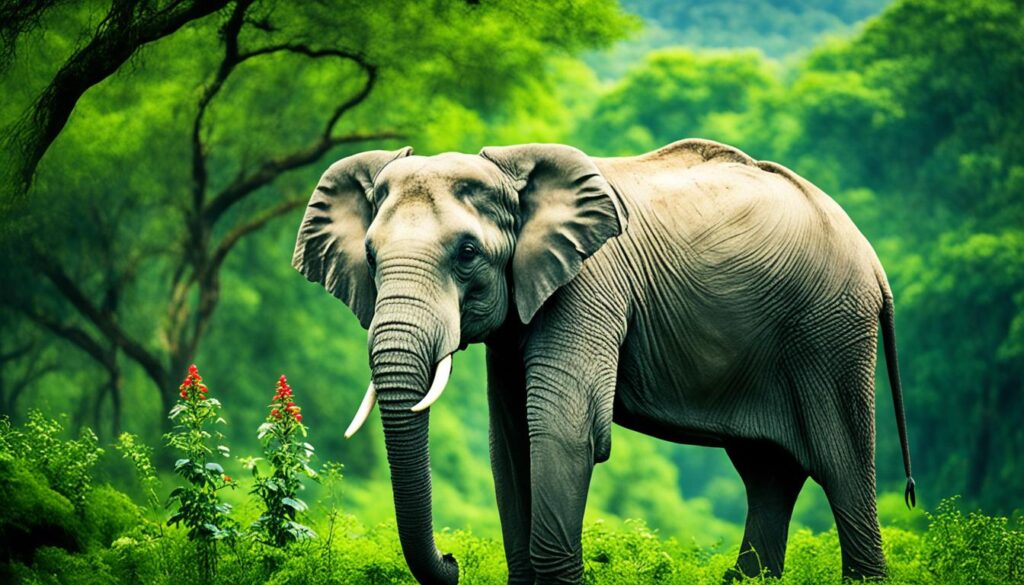
Indian Rhinoceros
The Indian rhinoceros, also known as the Greater One-Horned Rhinoceros, is a large mammal found in the Indian subcontinent. It inhabits the vast Terai grasslands and floodplain forests in northern India and Nepal. Indian rhinoceroses, scientifically known as Rhinoceros unicornis, are herbivorous creatures that sustain themselves by feeding on a variety of vegetation, including grasses, leaves, fruits, and aquatic plants.
The Indian rhinoceros is easily recognized by its one impressive horn, which is actually an outgrowth of the animal’s nose. This species has a sturdy build, with a thick skin that is gray-brown in color. Adult males can weigh up to 2,200 kilograms (4,850 pounds), making them one of the largest land mammals on the subcontinent. Females are usually smaller, weighing around 1,600 kilograms (3,530 pounds).
Unfortunately, the Indian rhinoceros is currently listed as endangered by the International Union for Conservation of Nature (IUCN). The main threats to their survival include habitat loss due to agricultural expansion and human encroachment, as well as poaching for their prized horns. Conservation efforts are underway to protect these magnificent creatures and their natural habitats in order to ensure their long-term survival.
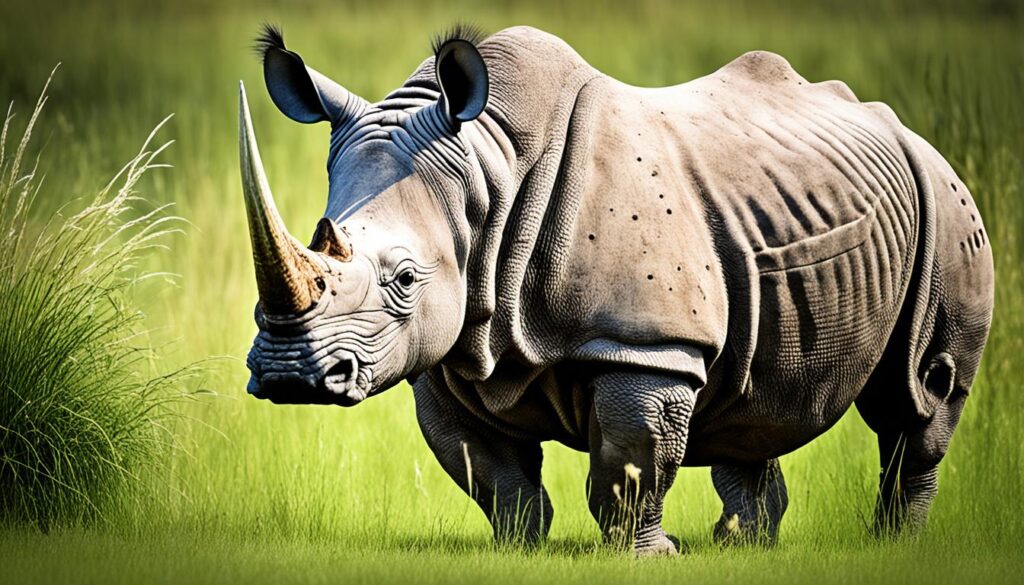
Indian Rhinoceros Facts and Figures:
| Data | Information |
|---|---|
| Scientific Name | Rhinoceros unicornis |
| Conservation Status | Endangered |
| Habitat | Terai grasslands and floodplain forests in northern India and Nepal |
| Diet | Herbivorous – grasses, leaves, fruits, and aquatic vegetation |
| Physical Characteristics | One horn, thick gray-brown skin, males weigh up to 2,200 kg (4,850 lb) |
Irish Setter
The Irish Setter, also known as the red setter, is a beloved breed of hunting dog with a friendly and energetic nature. These beautiful dogs are known for their stunning red coats, which are one of their distinguishing features. Not only are they visually appealing, but they also have a high level of intelligence, making them a joy to train and interact with.
Irish Setters are active dogs that require regular exercise to channel their energy and maintain their physical health. They love to run, play, and explore, making them excellent companions for individuals or families who enjoy an active lifestyle. Whether it’s going for long walks or engaging in outdoor activities, Irish Setters are always up for an adventure.
As a hunting dog breed, Irish Setters have a strong prey drive and a natural inclination for scent work. They excel in activities such as tracking, field trials, and obedience competitions. Their intelligence and trainability make them quick learners, and they thrive in environments where mental stimulation is provided.
Irish Setters are not only skilled hunters but also make great family pets. They are known for their affectionate and friendly nature, often forming strong bonds with their human companions. Their gentle and playful temperament makes them great with children, and they are generally accepting of other animals as well.
To ensure the well-being and happiness of an Irish Setter, it is essential to provide them with the attention and activity they require. Regular exercise, mental stimulation, and positive reinforcement training are key to keeping an Irish Setter happy and well-balanced. With the right care and environment, an Irish Setter can be a loyal, loving, and highly rewarding addition to any family.
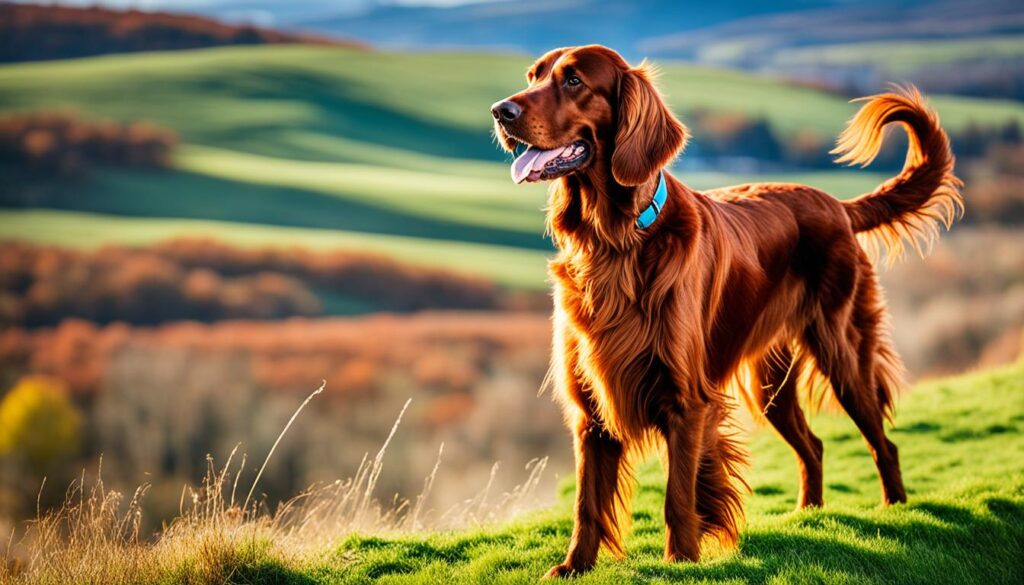
Key Characteristics of the Irish Setter:
- Friendly and energetic nature
- Stunning red coat
- Highly intelligent
- Requires regular exercise
- Strong prey drive
- Excellent family pet
| Characteristics | Details |
|---|---|
| Size | Medium to large |
| Coat | Medium to long, silky, and red in color |
| Temperament | Friendly, energetic, and affectionate |
| Exercise Needs | High – requires regular exercise and mental stimulation |
| Trainability | Intelligent and trainable |
| Prey Drive | Strong |
| Family Compatibility | Excellent – gets along well with children and other animals |
Irish Wolfhound
The Irish Wolfhound is a magnificent and sizable breed of dog known for its gentle and kind temperament. It is one of the largest dog breeds, often recognized for its towering height and noble appearance. Originating from Ireland, the Irish Wolfhound has a rich history and was traditionally valued for its hunting and guarding abilities.
Despite its imposing size, the Irish Wolfhound possesses a gentle and friendly nature, making it a beloved companion for families and individuals alike. This giant breed is known for its loyalty and unwavering devotion to its owners, often forming strong bonds with them.
To keep an Irish Wolfhound happy and healthy, regular exercise is essential due to its active nature. Daily walks or runs in a spacious area are beneficial to fulfill its exercise needs. Additionally, mental stimulation such as puzzle toys or training activities can help keep the Irish Wolfhound stimulated and engaged.
Irish Wolfhounds are well-suited for individuals or families who can accommodate their large size and provide them with the space they need to thrive. Despite their majestic presence, they are known to be gentle and patient with children, making them excellent family pets.
Overall, the Irish Wolfhound is a remarkable breed that combines size, grace, and a gentle temperament. Whether as a loyal companion or a faithful guardian, this magnificent giant breed leaves an indelible impression on those fortunate enough to be part of their lives.
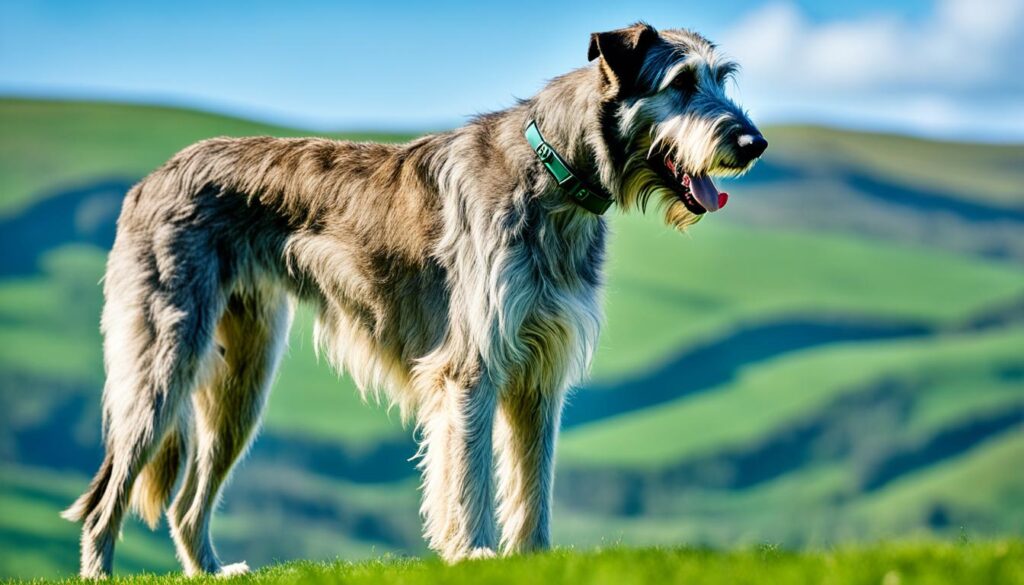
Conclusion
Exploring animals that start with I reveals the incredible diversity of the animal kingdom. From mammals to birds, reptiles, and invertebrates, each animal has its own unique characteristics and adaptations. It is important to appreciate and understand these creatures to support conservation efforts and protect their habitats. The animals that start with I are just a small glimpse into the vast array of wildlife found in our world.
The diverse animal kingdom showcases the marvels of nature and the intricate web of life. By studying and appreciating the varied species that inhabit our planet, we gain a deeper understanding of the interconnectedness of all living beings. Conservation efforts are crucial in preserving the rich biodiversity of Earth and ensuring the survival of these remarkable animals.
As we continue to learn more about the animals that start with I and other fascinating creatures, it is essential that we take action to protect their habitats and promote sustainable practices. By supporting conservation organizations, advocating for wildlife protection, and making informed choices, we can contribute to the preservation of our diverse animal kingdom for future generations to enjoy.
